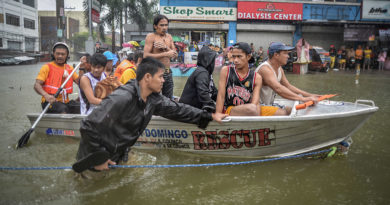Relation between coronavirus and global warming: Climate crisis changes disease pandemics
Climate change, habitat loss, antimicrobial resistance, and other factors are increasing the chances of global outbreak of novel diseases. The issue is, how do we minimise and manage these outbreaks
Is there any relationship between the new coronavirus outbreak and global warming? I have been asked this question many times by journalists ever since the outbreak started over a month ago. My answer has been a cautious one: It is too early to make any judgement on this matter. My answer is derived from the fact that while there is no evidence that global warming activated this virus to jump from animals to humans and helped its spread, there are enough scientific studies that indicate that a warming climate, along with a host of other factors, exacerbates the emergence of new infectious diseases. Let me elaborate.
Scientists have understood, for decades, that the climate crisis would change the way diseases emerge and spread out. But, they have also recognised that climate change is not the sole factor. Even without climate change, factors like habitat loss (deforestation), rapid urbanisation and globalisation, intensive meat production, and antimicrobial resistance would increase the chances of the emergence of new infectious diseases like COVID-19, which has brought China to a halt. What climate change does is multiply these risks by changing the growing environment of the pathogen and vectors, and by altering the disease-fighting ability of the human body.
Rising global temperature is enhancing the transmission period, and expanding the geographical distribution of diseases like dengue and malaria, as these infectious diseases thrive better in a warmer climate. For example, climate change is making winters milder, and shorter. This allows extended breeding periods for disease-carrying vectors such as mosquitoes, and rats. Warmer climates also enable them to survive in higher altitudes, and, therefore, bring diseases to new places. Global warming is also changing the water cycle, leading to heavy rainfalls, higher humidity, and floods. Higher temperature and humidity assist breeding of pathogens, and heavy rain assists the breeding of mosquitoes. Overall, both the pathogen and the vector thrive in a warmer and more humid climate.
Climate change, along with habitat loss and intensive animal farms, is also bringing humans and animals into closer proximity. This is increasing the likelihood of transfer of bacteria and viruses from animals to humans. It is, therefore, not surprising that the all the global outbreak in recent history—Severe acute respiratory syndrome (SARS), the Zika virus, and the Middle East respiratory syndrome (MERS)—are zoonotic diseases; these viruses have moved from animals to humans.
Climate change is also making our natural immune systems less effective, thereby making us susceptible to novel pathogens. The human body is designed to fight diseases. Our body produces antibodies to neutralise bacteria and viruses. But, our body also kills pathogens by increasing its internal temperature. When a pathogen enters our body, we get a fever, warming us even more to fight off disease. In many cases, the heat itself is sufficient to neutralise the pathogen(s).
But, with a warming planet, pathogens are surviving in higher temperatures outside the human body. They, therefore, are becoming better equipped to withstand the high heat inside it. The pathogens that survive in the human body are producing offspring that are even better adapted to higher temperatures—this is called natural selection. And, with this natural selection, our body’s primary defence mechanisms are losing their effectiveness. On top of this, modern medicine is becoming less effective because of antimicrobial resistance (AMR).
AMR is turning out to be a global health crisis of an unprecedented scale. The misuse and overuse of antibiotics, and antiviral drugs in humans and animals is now producing superbugs that cannot be treated with modern medicine. In fact, we currently misuse more antibiotics in animals than in humans. The biggest worry today is the emergence of superbugs from animals that could infect a large human population.
So, on the one hand, climate change and other factors are leading to the emergence of new zoonotic diseases and making our bodies more susceptible to these diseases, and on the other hand, AMR is producing superbugs in animals, making medicines less and less effective. This is the crux of the problem—there is a complex interplay of climate change, AMR, and a host of other factors that would keep producing novel viruses and bacteria. And, so long as people live close together in cities and international travel is easy, global outbreaks of infectious diseases are unavoidable. We will have to live with these outbreaks. The question today, therefore, is not whether these pandemics will happen or not; they will. The issue is, how do we minimise and manage these outbreaks.
The biggest global pandemic in the last 100 years was the Spanish flu that killed close to 50 million people across the world in between 1918 and 1920. This was caused by the H1N1 influenza virus, and infected around one-fourth of the global population. A new strain of swine-origin H1N1 also became a pandemic in 2009-2010. It led to the death of around 17,000 people—a mortality 3,000 times lower than that obtained during the Spanish flu. In other words, though the chances of outbreaks have increased significantly in the last few decades, our ability to contain them has also improved considerably. We now have unprecedented global cooperation during such outbreaks. Going ahead, we will have to keep strengthening these cooperative mechanisms and work together to contain the spread of epidemics. But, we will also have to work to minimise the outbreaks.
The World Health Organization (WHO) has estimated that climate change will cause about 250,000 additional deaths per year by the 2030s. It has also projected that if no action is taken, drug-resistant diseases could cause 10 million deaths each year by 2050. Working both on the climate crisis and AMR, therefore, is key to containing the emergence and spread of new diseases. We must address these conjoined issues to safeguard our health.
This was originally published by financialexpress.com




